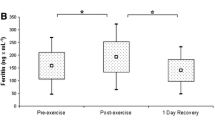Summary
The present study was designed to evaluate the effect of an intensive physical training program involving both isometric and isotonic activities on the body iron status of 8 females and 11 males (age 20± 1 year). The training was carried out over a 7 week period and included 8 h of varying physical activities each day. Venous blood samples were obtained from the subjects prior to the beginning of the training, on day 2 and in weeks 2, 4, 6 and 7 of the program. Blood samples were analyzed for iron, ferritin and hemoglobin (Hb) concentrations, total iron binding capacity (TIBC) and red blood cell count (RBC). Iron levels of males and females decreased 65% after 2 weeks of training (p<0.001). At the end of the training program 5 males and 6 females had lower than normal iron values (<13.4 μmol·l−1). TIBC increased 25% in women and 18% in men following 2 and 4 weeks of training (p<0.001) and remained at this elevated level throughout the training period. Ferritin levels decreased 50% in both sexes after 4 weeks of exercise (p<0.05) and remained at this level until the end of the training. Hb and RBC decreased 8–10% in both sexes during the training period. In two of the women anemia occurred after 4 weeks of training. The development of latent iron deficiency in a substantial number of participants after a relatively short period of training is uncommon and may reflect the high intensity of exercise required in this program. The decline in body iron status may affect the performance of the subject during training. We suggest that the iron status of athletes engaged in intensive training be examined regularly and consideration be given to iron supplementation.
Similar content being viewed by others
References
Banister EW, Hamilton CL (1985) Variations in iron status with fatigue modelled from training in female distance runners. Eur J Appl Physiol 54:16–23
Clement DB, Asmundson RC (1982) Nutritional intake and hematological parameters in endurance runners. Physic Sport Med 10:37–43
Clement DB, Sawchuk LL (1984) Iron status and sports performance. Sports Med 1:65–74
Colt E, Heyman B (1984) Low ferritin levels in runners. J Sports Med 24:13–16
Davies KJA, Donovan CM, Refino CJ, Brooks GA, Packer L, Dallman PR (1984) Distinguishing effects of anemia and muscle iron deficiency on exercise bioenergetics in the rat. Am J Physiol 246:E535-E543
Dufaux B, Hoederath A, Streitberger I, Hollman W, Assmann G (1981) Serum ferritin, transferrin, haptoglobin, and iron in middle- and long-distance runners, elite rowers, and professional racing cyclists. Int J Sports Med 2:43–46
Ehn L, Carlmark B, Hoglund S (1980) Iron status in athletes involved in intense physical activity. Med Sci Sports Exerc 12:61–64
Gardner GW, Edgerton VR, Barnard RJ, Bernauer EM (1975) Cardiorespiratory, hematological and physical performance responses of anemic subjects to iron treatment. Am J Clin Nutr 28:982–988
Hunding A, Jordal R, Paulev PE (1981) Runner's anemia and iron deficiency. Acta Med Scand 209:315–318
Macdonald VW, Charache S, Hathaway PJ (1985) Iron deficiency anemia: mitochondrial — glycerophosphate dehydrogenase in guinea pig skeletal muscle. J Clin Med 105:11–18
Plowman SA, McSwegin PC (1981) The effect of iron supplementation on females cross country runners. J Sports Med 21:407–416
Stewart JG, Ahlquist DA, McGill DB, Ilstrup DM, Schwarts S, Owen RA (1984) Gastrointestinal blood loss and anemia in runners. Ann Int Med 100:843–845
Convertino VA, Brock PJ, Keil LC, Bernauer EM, Greenleaf JE (1980) Exercise training-induced hypervolemia: role of plasma albumin, renin and vasopressin. J Appl Physiol 48:445–669
Yoshimura H, Inoue T, Yamada T, Shiraki K (1980) Anemia during hard physical training (sports anemia) and its causal mechanism with special reference to protein nutrition. Wld Rev Nutr Diet 35:1–86
Author information
Authors and Affiliations
Additional information
This study was partly supported by a grant from the Chief Scientist, Ministry of Health, Israel and by The Israeli Sport Authority
Rights and permissions
About this article
Cite this article
Magazanik, A., Weinstein, Y., Dlin, R.A. et al. Iron deficiency caused by 7 weeks of intensive physical exercise. Europ. J. Appl. Physiol. 57, 198–202 (1988). https://doi.org/10.1007/BF00640663
Accepted:
Issue Date:
DOI: https://doi.org/10.1007/BF00640663




